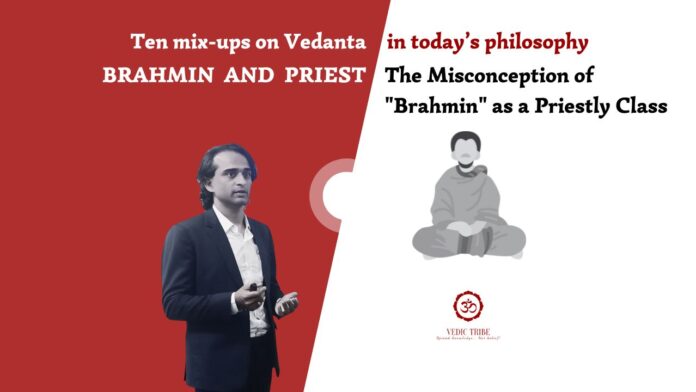The Misconception of “Brahmin” as a Priestly Class
In the previous article we discussed the difference between Mantra and Hymn. In this article, we will discuss why the term “priest” is a misnomer for the term “Brahmin”.
The term “Brahmin” often gets misunderstood in Western contexts, particularly when equated with the role of a “priest.” While the two concepts are related, they are not synonymous.
The Vedic Perspective
Path of spiritual inquiry: In Vedic tradition, the term “Brahmin” primarily refers to a person who is spiritually aware and seeks to realize the ultimate reality, Brahman and it is not tied to birth. Furthermore, those who consciously choose to walk the path of spiritual awareness and inquiry – were classified as “Brahmana Varna”. In Sanskrit “varna” simply means “colour” indicating a method of social classification. This original idea does not include class hierarchy and birth-rights.
Varna vs Jati: While the Vedic perspective of “Brahmin Varna” is wide in concept & liberal, regional perspective of “Brahmin Jati” is narrow & involves assertion of birth-rights.
Purohita: The actual person who conducts religious rituals is often referred to as the “Yajamana.” They are assisted by learned individuals known as “Purohitas,” who are well-versed in the Vedas and guide the rituals. Instead of “brahmin”, it is purohita who’s role is little similar to priest.
Priest in Judeo-Christian Traditions
Role: A priest is typically ordained to perform religious rites, such as administering sacraments, leading worship services, and providing spiritual counsel.
Authority: The authority of a priest often derives from a hierarchical religious institution.
Focus: The primary focus is on the relationship between the individual and a higher power, often a personal God.
Western Misinterpretation
The root cause: Due to the onslaught of Turkish and Mughal invasions, many ancient systems including the liberal Varna systems vanished and conservative jati system gained popularity as the local population moved from liberalism to protectionism. As a result, in the later classical Sanskrit literature, like novels, dharma shastras…etc one can see linguistic mix-up of varna & jati.
Colonial influence: Later, western philosophers categorized Brahmins as a “priestly class,” equating them with the role of priests in Western religions. This interpretation, in few literatures is simplification that overlooks the deeper spiritual significance of the Brahmin identity. However, in most of the western literature designed to spread colonial propaganda such misinterpretations are deliberate and have become mainstream in scholarly world today.
Purohita in Vedic Tradition
Role: A Purohita is a Vedic scholar who guides the Yajamana in the performance of Vedic rituals, particularly Yajna.
Authority: The authority of a Purohita stems from their knowledge of the Vedas and their ability to perform rituals correctly.
Focus: There are four purohitas in Yajna. “Hotr” for strict pronunciation of mantras (representing Rigveda), “Adhvaryu” for correct performance of ritual (representing Yajurveda), “Udgatru” for enchanting singing of Veda (representing Samaveda) and “Brahma” to supervise the entire process (representing Atharva Veda).
It is more accurate to use the term “Purohita” when referring to a priest in the Vedic context, and to reserve “Brahmin” for its original, spiritually-oriented meaning. By understanding this distinction, we can appreciate the rich and complex nature of Vedic philosophy and the roles of individuals within its framework.
Key takeaways:
When you hear someone use the term priest in Vedic context, politely correct them to use “purohita” or “brahmin”. Further you may directly witness the living Vedic tradition of rituals in the state of Kerala to understand the role of “purohita”
In the next article, we will discuss the seventh mix-up – “Asthika and Theist”.
Madhwesh K
Vedic Tribe

